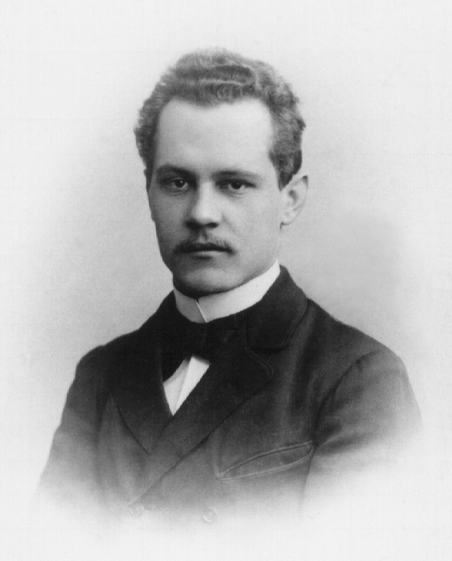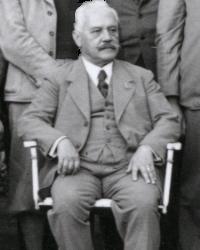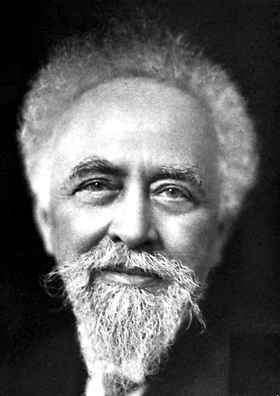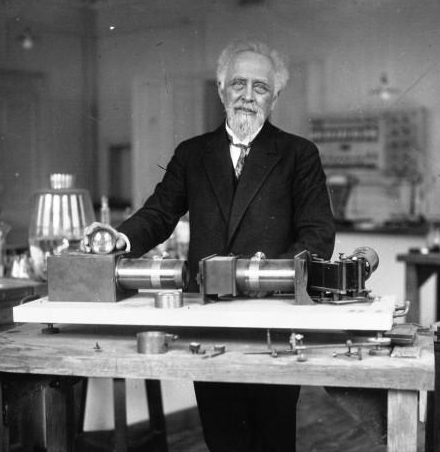<Back to Index>
- Physicist Arnold Johannes Wilhelm Sommerfeld, 1868
- Physicist Jean Baptiste Perrin, 1870
PAGE SPONSOR


Arnold Johannes Wilhelm Sommerfeld FRS (5 December 1868 – 26 April 1951) was a German theoretical physicist who pioneered developments in atomic and quantum physics, and also educated and groomed a large number of students for the new era of theoretical physics. He was nominated a record 81 times for the Nobel Prize, and served as PhD supervisor for more Nobel prize winners in physics than any other supervisor before or since. He introduced the 2nd quantum number (azimuthal quantum number) and the 4th quantum number (spin quantum number). He also introduced the fine - structure constant, and pioneered X-ray wave theory.
Sommerfeld studied mathematics and physical sciences at the Albertina University of his native city, Königsberg, East Prussia. His dissertation advisor was the mathematician Ferdinand von Lindemann, and he also benefited from classes with mathematicians Adolph Hurwitz and David Hilbert, and physicist Emil Wiechert. His participation in the student fraternity Deutsche Burschenschaft resulted in a fencing scar on his face. He received his Ph.D. in 1891 (age 23).
After receiving his doctorate, Sommerfeld remained at Königsberg to
work on his teaching diploma. He passed the national exam in 1892 and
then began a year of military service, which was done with the reserve
regiment in Königsberg. He completed his obligatory military service in
September 1893, and for the next eight years continued voluntary
eight - week military service. With his turned up mustache, his physical
build, his Prussian bearing, and the fencing scar on his face, he gave the impression of being a colonel in the hussars.
In October, Sommerfeld went to the University of Göttingen, which was the center of mathematics in Germany. There, he became assistant to Theodor Liebisch, at the Mineralogical Institute, through a fortunate personal contact – Liebisch had been a professor at the University of Königsberg and a friend of the Sommerfeld family.
In September 1894, Sommerfeld became Felix Klein's assistant, which included taking comprehensive notes during Klein's lectures and writing them up for the Mathematics Reading Room, as well as managing the reading room. Sommerfeld's Habilitationsschrift was completed under Klein, in 1895, which allowed Sommerfeld to become a Privatdozent at Göttingen. As a Privatdozent, Sommerfeld lectured on a wide range of mathematical and mathematical physics topics. His lectures on partial differential equations were first offered at Göttingen, and they evolved over his teaching career to become Volume VI of his textbook series Lectures on Theoretical Physics, under the title Partial Differential Equations in Physics.
Lectures by Klein in 1895 and 1896 on rotating bodies led Klein and Sommerfeld to write a four volume text Die Theorie des Kreisels – a 13-year collaboration, 1897 – 1910. The first two volumes were on theory, and the latter two were on applications in geophysics, astronomy and technology. The association Sommerfeld had with Klein influenced Sommerfeld's turn of mind to be applied mathematics and in the art of lecturing.
While at Göttingen, Sommerfeld met Johanna Höpfner, daughter of Ernst Höpfner, curator at Göttingen. In October, 1897 Sommerfeld began the appointment to the Chair of Mathematics at the Bergakademie in Clausthal - Zellerfeld; he was successor to Wilhelm Wien. This appointment provided enough income to eventually marry Johanna.
At Klein's request, Sommerfeld took on the position of editor of Volume V of Encyklopädie der mathematischen Wissenschaften; it was a major undertaking which lasted from 1898 to 1926.
In 1900, Sommerfeld started his appointment to the Chair of Applied Mechanics at the Königliche Technische Hochschule Aachen
(later RWTH Aachen University) as extraordinarius professor, which was
arranged through Klein's efforts. At Aachen, he developed the theory of hydrodynamics,
which would retain his interest for a long time. Later, at the
University of Munich, Sommerfeld's students Ludwig Hopf and Werner
Heisenberg would write their Ph.D. theses on this topic.
From 1906 Sommerfeld established himself as ordinarius professor of physics and director of the new Theoretical Physics Institute at the University of Munich. He was selected for these positions by Wilhelm Röntgen, Director of the Physics Institute at Munich, which was looked upon by Sommerfeld as being called to a "privileged sphere of action."
Up until the late 19th century and early 20th century, experimental physics in Germany was considered as having a higher status within the community. However, in the early 20th century, theorists, such as Sommerfeld at Munich and Max Born at the University of Göttingen, with their early training in mathematics turned this around so that mathematical physics, i.e., theoretical physics, became the prime mover and experimental physics was used to verify or advance theory. After getting their doctorates with Sommerfeld, Wolfgang Pauli, Werner Heisenberg, and Walter Heitler became Born's assistants and made significant contributions to the development of quantum mechanics, which was then in very rapid development.
Over his 32 years of teaching at Munich, Sommerfeld taught general and specialized courses, as well as holding seminars and colloquia. The general courses were on mechanics, mechanics of deformable bodies, electrodynamics, optics, thermodynamics and statistical mechanics, and partial differential equations in physics. They were held four hours per week, 13 weeks in the winter and 11 weeks in the summer, and were for students who had taken experimental physics courses from Röntgen and later by Wilhelm Wien. There was also a two hour weekly presentation for the discussion of problems. The specialized courses were of topical interest and based on Sommerfeld's research interests; material from these courses appeared later in the scientific literature publications of Sommerfeld. The objective of these special lectures was to grapple with current issues in theoretical physics and for Sommerfeld and the students to garner a systematic comprehension of the issue, independent of whether or not they were successful in solving the problem posed by the current issue. For the seminar and colloquium periods, students were assigned papers from the current literature and they then prepared an oral presentation. From 1942 to 1951, Sommerfeld worked on putting his lecture notes in order for publication. They were published as the six volume Lectures on Theoretical Physics.
Four of Sommerfeld's doctoral students, Werner Heisenberg, Wolfgang Pauli, Peter Debye, and Hans Bethe went on to win Nobel Prizes, while others, most notably, Walter Heitler, Rudolf Peierls, Karl Bechert, Hermann Brück, Paul Peter Ewald, Eugene Feenberg, Herbert Fröhlich, Erwin Fues, Ernst Guillemin, Helmut Hönl, Ludwig Hopf, Adolf Kratzer, Otto Laporte, Wilhelm Lenz, Karl Meissner, Rudolf Seeliger, Ernst C. Stückelberg, Heinrich Welker, Gregor Wentzel, Alfred Landé, and Léon Brillouin became famous in their own right. Three of Sommerfeld's postgraduate students, Linus Pauling, Isidor I. Rabi and Max von Laue, won Nobel Prizes, and ten others, William Allis, Edward Condon, Carl Eckart, Edwin C. Kemble, William V. Houston, Karl Herzfeld, Walther Kossel, Philip M. Morse, Howard Robertson, and Wojciech Rubinowicz went on to become famous in their own right. Walter Rogowski, an undergraduate student of Sommerfeld at RWTH Aachen, also went on to become famous in his own right. Max Born believed Sommerfeld's abilities included the "discovery and development of talents." Albert Einstein told Sommerfeld: "What I especially admire about you is that you have, as it were, pounded out of the soil such a large number of young talents." Sommerfeld's style as a professor and institute director did not put distance between him and his colleagues and students. He invited collaboration from them, and their ideas often influenced his own views in physics. He entertained them in his home and met with them in cafes before and after seminars and colloquia. Sommerfeld owned an alpine ski hut to which students were often invited for discussions of physics as demanding as the sport.
While at Munich, Sommerfeld came in contact with the special theory of relativity by Albert Einstein, which was not yet widely accepted at that time. His mathematical contributions to the theory helped its acceptance by the skeptics. In 1914 he worked with Léon Brillouin on the propagation of electromagnetic waves in dispersive media. He became one of the founders of quantum mechanics; some of his contributions included co-discovery of the Sommerfeld – Wilson quantization rules (1915), a generalization of Bohr's atomic model, introduction of the Sommerfeld fine - structure constant (1916), co-discovery with Walther Kossel of the Sommerfeld – Kossel displacement law (1919), and published Atombau und Spektrallinien (1919), which became the "bible" of atomic theory for the new generation of physicists who developed atomic and quantum physics.
In 1918, Sommerfeld succeeded Einstein as chair of the Deutsche Physikalische Gesellschaft (DPG). One of his accomplishments was the founding of a new journal. The scientific papers published in DPG journals became so voluminous, a committee of the DPG, in 1919, recommended the establishment of Zeitschrift für Physik for publication of original research articles, which commenced in 1920. Since any reputable scientist could have their article published without refereeing, time between submission and publication was very rapid – as fast as two weeks time. This greatly stimulated the scientific theoretical developments, especially that of quantum mechanics in Germany at that time, as this journal was the preferred publication vehicle for the new generation of quantum theorists with avant garde views.
In the winter semester of 1922 - 1923, Sommerfeld gave the Carl Schurz Memorial Professor of Physics lectures at the University of Wisconsin – Madison.
In 1927 Sommerfeld applied Fermi – Dirac statistics to the Drude model of electrons in metals – a model put forth by Paul Drude. The new theory solved many of the problems predicting thermal properties the original model had and became known as the Drude – Sommerfeld model.
In 1928 - 1929, Sommerfeld traveled around the world with major stops in India, China, Japan and the United States.
Sommerfeld was a great theoretician, and besides his invaluable
contributions to the quantum theory, he worked in other fields of
physics, such as the classical theory of electromagnetism. For example,
he proposed a solution to the problem of a radiating hertzian dipole
over a conducting earth, which over the years led to many applications.
His Sommerfeld identity
and Sommerfeld integrals are still to the present day the most common
way to solve this kind of problem. Also, as a mark of the prowess of
Sommerfeld's school of theoretical physics and the rise of theoretical
physics in the early 1900s, as of 1928, nearly one - third of the
ordinarius professors of theoretical physics in the German speaking
world were students of Sommerfeld.
On 1 April 1935 Sommerfeld achieved emeritus status, however, he stayed on as his own temporary replacement during the selection process for his successor, which took until 1 December 1939. The process was lengthy due to academic and political differences between the Munich Faculty's selection and that of both the Reichserziehungsministerium (Acronym: REM, and translation: Reich Education Ministry.) and the supporters of Deutsche Physik, which was anti - Semitic and had a bias against theoretical physics, especially including quantum mechanics. The appointment of Wilhelm Müller – who was not a theoretical physicist, had not published in a physics journal, and was not a member of the Deutsche Physikalische Gesellschaft – as a replacement for Sommerfeld, was considered such a travesty and detrimental to educating a new generation of physicists that both Ludwig Prandtl, director of the Kaiser Wilhelm Institut für Strömungsforschung (Kaiser Wilhelm Institute for Flow Research), and Carl Ramsauer, director of the research division of the Allgemeine Elektrizitäts - Gesellschaft (General Electric Company) and president of the Deutsche Physikalische Gesellschaft, made reference to this in their correspondence to officials in the Reich. In an attachment to Prandtl's 28 April 1941 letter to Reich Marshal Hermann Göring, Prandtl referred to the appointment as "sabotage" of necessary theoretical physics instruction. In an attachment to Ramsauer's 20 January 1942 letter to Reich Minister Bernhard Rust, Ramsauer concluded that the appointment amounted to the "destruction of the Munich theoretical physics tradition."
Sommerfeld was awarded many honors in his lifetime, such as the Lorentz Medal, the Max - Planck Medal, the Oersted Medal, election to the Royal Society of London, the United States National Academy of Sciences, Academy of Sciences of the USSR, the Indian Academy of Sciences, and other academies including those in Berlin, Munich, Göttingen, and Vienna, as well as having conferred on him numerous honorary degrees from universities including Rostock, Aachen, Calcutta and Athens.
In 2004, the center for theoretical physics at the University of Munich was named after him.
Though Sommerfeld was nominated for the Nobel Prize 81 times, more than any other physicist, he never received the award.
Sommerfeld died in 1951 in Munich from injuries after a traffic accident while walking with his grandchildren.


Jean Baptiste Perrin FRS (30 September 1870 – 17 April 1942) was a French physicist and Nobel laureate.
Born in Lille, France, Perrin attended the École Normale
Supérieure, the elite grande école in Paris. He became an assistant at
the school during the period of 1894 - 97 when he began the study of cathode rays and X-rays. He was awarded the degree of docteur ès sciences
(PhD) in 1897. In the same year he was appointed as a lecturer in
physical chemistry at the Sorbonne, Paris. He became a professor at the
University in 1910, holding this post until the German occupation of France during World War II.
In 1895, Jean Perrin showed that cathode rays were made of corpuscles with negative electric charge. He computed Avogadro's number through several methods. He explained solar energy by the thermonuclear reactions of hydrogen.
After Albert Einstein published (1905) his theoretical explanation of Brownian motion in terms of atoms, Perrin did the experimental work to test and verify Einstein's predictions, thereby settling the century long dispute about John Dalton's atomic theory.
Jean Perrin received the Nobel Prize in Physics in 1926 for this and other work on the discontinuous structure of matter, which put a definite end to the long struggle regarding the question of the physical reality of molecules.
Perrin was the author of a number of books and dissertations. Most notable of his publications were: "Rayons cathodiques et rayons X" ; "Les Principes"; "Electrisation de contact"; "Réalité moléculaire"; "Matière et Lumière"; "Lumière et Reaction chimique".
Perrin was also the recipient of numerous prestigious awards including the Joule Prize of the Royal Society in 1896 and the La Caze Prize of the Paris Academy of Sciences. He was twice appointed a member of the Solvay Committee at Brussels in 1911 and in 1921. He also held memberships with the Royal Society of London and with the Academies of Sciences of Belgium, Sweden, Turin, Prague, Romania and China. He became a Commander of the Legion of Honour in 1926 and was made Commander of the Order of Léopold (Belgium).
In 1927, he founded the Institut de Biologie Physico - Chimique together with chemist André Job and physiologist André Mayer. Funding was provided by Edmond James de Rothschild. In 1937, Perrin established the Palais de la Découverte, a science museum in Paris.
Jean Perrin is considered the founding father of the CNRS. Following a petition by Perrin signed by over 80 scientists, among them eight Nobel Prize laureates, the French education minister set up the Conseil Supérieur de la Recherche Scientifique (French National Research Council) in April 1933. In 1936 Perrin, now an undersecretary for research, founded the Service Central de la Recherche Scientifique (French Central Agency for Scientific Research). Both institutions were merged under the CNRS umbrella on October 19, 1939.
His notable students include Pierre Victor Auger. Perrin was the father of Francis Perrin, also a physicist.
Perrin was an officer in the engineer corps during World War I. When the Germans invaded France in 1940, he escaped to the U.S.A. where he died in New York City. After the War, in 1948, his remains were transported back to France by the battleship Jeanne d'Arc and buried in the Panthéon.